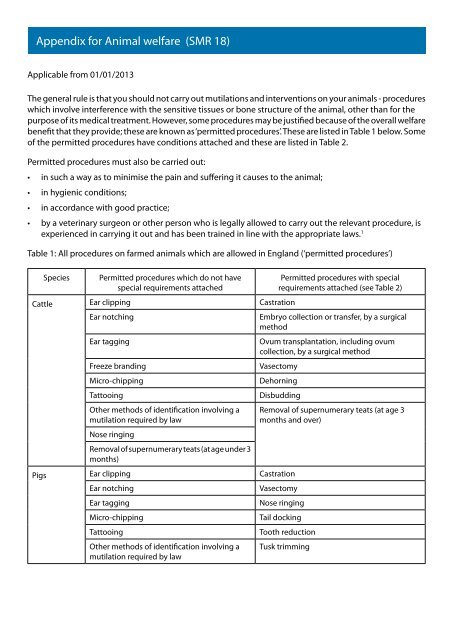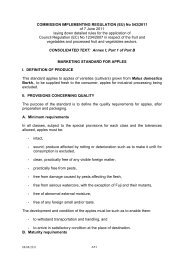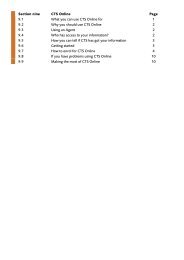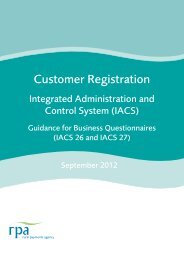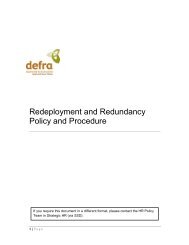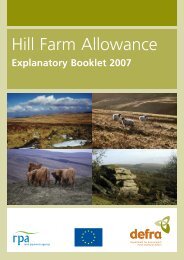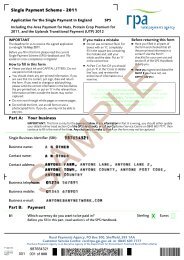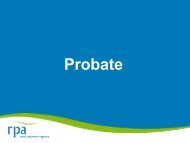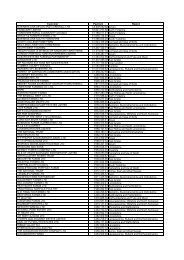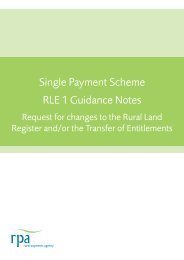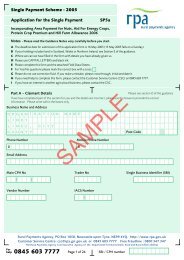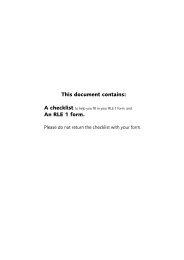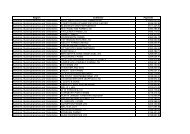SMR 18 Animal welfare Appendix.pdf
SMR 18 Animal welfare Appendix.pdf
SMR 18 Animal welfare Appendix.pdf
Create successful ePaper yourself
Turn your PDF publications into a flip-book with our unique Google optimized e-Paper software.
<strong>Appendix</strong> for <strong>Animal</strong> <strong>welfare</strong> (<strong>SMR</strong> <strong>18</strong>)Applicable from 01/01/2013The general rule is that you should not carry out mutilations and interventions on your animals - procedureswhich involve interference with the sensitive tissues or bone structure of the animal, other than for thepurpose of its medical treatment. However, some procedures may be justified because of the overall <strong>welfare</strong>benefit that they provide; these are known as ‘permitted procedures’. These are listed in Table 1 below. Someof the permitted procedures have conditions attached and these are listed in Table 2.Permitted procedures must also be carried out:• in such a way as to minimise the pain and suffering it causes to the animal;• in hygienic conditions;• in accordance with good practice;• by a veterinary surgeon or other person who is legally allowed to carry out the relevant procedure, isexperienced in carrying it out and has been trained in line with the appropriate laws. 1Table 1: All procedures on farmed animals which are allowed in England (‘permitted procedures’)SpeciesPermitted procedures which do not havespecial requirements attachedPermitted procedures with specialrequirements attached (see Table 2)Cattle Ear clipping CastrationEar notchingEmbryo collection or transfer, by a surgicalmethodEar taggingFreeze brandingMicro-chippingTattooingOther methods of identification involving amutilation required by lawNose ringingRemoval of supernumerary teats (at age under 3months)Ovum transplantation, including ovumcollection, by a surgical methodVasectomyDehorningDisbuddingPigs Ear clipping CastrationEar notchingVasectomyEar taggingMicro-chippingTattooingOther methods of identification involving amutilation required by lawRemoval of supernumerary teats (at age 3months and over)Nose ringingTail dockingTooth reductionTusk trimming
BirdsNone of the procedures listed below, apart from beak trimming, may be performed on;1 conventionally reared meat chickens 2 ; or2 a laying hen, or a chick that is intended to become a laying hen, which is kept on anestablishment with 350 or more such birds.Micro-chippingOther methods of identification involving amutilation required by lawDe-toeing of domestic fowl and turkeys (under3 days)Beak trimming of poultryNeck taggingWeb notchingWeb taggingWing taggingDesnooding of turkeysDe-toeing of domestic fowl and turkeys (at age3 days and over)Dubbing of domestic fowl (under 3 days) Dubbing of domestic fowl (at age 3 days andover)LaparoscopySheep Ear clipping CastrationEar notchingVasectomyEar taggingDehorningMicro-chippingTail dockingTattooingOther methods of identification involving amutilation required by lawDisbuddingRemoval of the insensitive tip of the hornGoats Ear clipping CastrationEar notchingVasectomyEar taggingDehorningMicro-chippingTattooingOther methods of identification involving amutilation required by lawDisbuddingRemoval of the insensitive tip of the hornHorses Freeze branding CastrationHot brandingVasectomyMicro-chippingTattooingOther methods of identification involving amutilation required by law
Deer Ear clipping CastrationDogsEar notchingEar taggingMicro-chippingTattooingOther methods of identification involving amutilation required by lawRemoval of the dew clawVasectomyAntler removalOther species Ear clipping CastrationEar notchingVasectomyTaggingMicro-chippingTattooingOther methods of identification involving amutilation required by lawTable 2: Conditions attached to certain permitted proceduresProcedureAge of animalat whichprocedure maybe carried outAnaestheticrequirement forprocedure atspecified ageOther conditionsCattleCastration: carried out by meansof a rubber ring or other device toconstrict the flow of blood to thescrotumCastration: carried out by meansother than a rubber ring or otherdevice to constrict the flow ofblood to the scrotum7 days or under Not requiredUnder 2 months Not required2 months or over RequiredEmbryo collection or transfer, bya surgical methodOvum transplantation, includingovum collection, by a surgicalmethodAny ageAny ageRequiredRequiredVasectomy Any age RequiredDehorning Any age RequiredDisbudding: carried out bychemical cauterisationDisbudding: carried out by amethod other than chemicalcauterisation7 days or under Not required6 months orunderRequiredRemoval of supernumerary teats 3 months or over Required
PigsCastration Under 7 days Not required The method does not involve tearing ofthe tissuesVasectomy Any age Required7 days or over Required i. The method does not involvetearing of the tissuesii. Must be carried out by a veterinarysurgeon.iii. Additional prolonged analgesiamust be givenNose ringing Any age Not required The pig must not be kept continuously inan indoor husbandry systemTail docking Under 7 days Not required i. Other measures to improveenvironmental conditions ormanagement systems have firstbeen taken to prevent tail bitingbut there is still evidence to showthat injuries to pigs’ tails by bitinghas occurredii. The method involves quick andcomplete severance of the tail7 days or over Required i. Other measures to improveenvironmental conditions ormanagement systems have firstbeen taken to prevent tail bitingbut there is still evidence to showthat injuries to pigs’ tails by bitinghas occurredii. Must be carried out by a vetenarysurgeon.iii. The method involves quick andcomplete severance of the tailiv. Additional prolonged analgesiamust be given
Tooth reduction 7 days or under Not required i. Method must consist only of theuniform reduction of corner teeth bymeans of grinding or clippingii. An intact, smooth surface is leftiii. Other measures to improveenvironmental conditions ormanagement systems have beentaken in order to prevent tail bitingand other vices but there is stillevidence that injuries to sows’ teatsor other pigs’ ears or tails by bitinghas occurredTusk trimming Any age Not required May only be carried out where thereis evidence to show it is necessary toprevent injury to other animals or forsafety reasonsBirdsBeak trimming of poultry(‘poultry’ includes laying hens -and chicks intended to becomelaying hens - which are kept onestablishments where there areless than 350 such birds)Beak trimming of laying hens -and chicks intended to becomelaying hens - which are kept onestablishments where there are350 or more such birdsAny age Not required i. It is performed using a suitableinstrumentii. It is performed either:a. on both the lower and upperbeaks and not more than one thirdof each is removed, orb. on the upper beak only and notmore than one third is removed.iii. Any subsequent haemorrhage fromthe beak is arrested by cauterisation.Under 10 days(unless wherethe procedureis carried out inan emergency inorder to controlan outbreak offeather peckingor cannibalism)Not requiredi. It is performed using a suitableinstrumentii. it is performed using infra-redtechnology (unless where theprocedure is carried out in anemergency in order to control anoutbreak of feather pecking orcannibalism)iii. it is performed either:a. on both the lower and upperbeaks and not more than one thirdof each is removed, orb. on the upper beak only and notmore than one third is removediv. any subsequent haemorrhage fromthe beak is arrested by cauterisationv. may only be carried out in orderto prevent feather pecking orcannibalismvi. may only be carried out by a personwho has been provided with suitableand sufficient information, instructionand training so that they are qualifiedto perform the procedure
Beak trimming of conventionallyreared meat chickensUnder 10 days Not required i. It is performed using a suitableinstrumentii. it is performed either:a. on both the lower and upperbeaks and not more than one thirdof each is removed, orb. on the upper beak only and notmore than one third is removediii. any subsequent haemorrhage fromthe beak is arrested by cauterisationiv. may only be carried out in orderto prevent feather pecking andcannibalismv. may only be carried out by a personwho has been provided with suitableand sufficient information, instructionand training so that they are qualifiedto perform the procedurevi. may only be carried out following aconsultation and on the advice of aveterinarian.Neck tagging of farmed ducks 3 days or under Not required To be carried out only for the purposesof a breed improvement programmeWeb notching of farmed ducks 3 days or under Not required To be carried out only for the purposesof a breed improvement programmeWeb tagging of farmed birds Any age Not required To be carried out only for the purposesof breed improvement programmes ortesting for the presence of diseaseWing tagging of farmed bird Any age Not required To be carried out only for the purposesof breed improvement programmes ortesting for the presence of diseaseDesnooding of turkeys 21 days or under Not required To be carried out either by manualpinching-out or with a suitableinstrument.De-toeing of domestic fowl andturkeys3 days or over Required To be carried out only if considerednecessary by a veterinary surgeonDubbing of domestic fowl 3 days or over Required It shall be carried out only if considerednecessary by a veterinary surgeonLaparoscopy Any age RequiredSheepCastration: carried out by meansof a rubber ring or other device toconstrict the flow of blood to thescrotumCastration: carried out by meansother than a rubber ring or otherdevice to constrict the flow ofblood to the scrotum7 days or under Not requiredUnder 3 months Not required3 months or over RequiredVasectomy Any age RequiredDehorning Any age Required
Tail docking: carried out bymeans of a rubber ring or otherdevice to constrict the flow ofblood to the tailTail docking: carried out otherthan by means of a rubber ring orother device to constrict the flowof blood to the tailGoatsCastration: carried out by meansof a rubber ring or other device toconstrict the flow of blood to thescrotumCastration: carried out by meansother than a rubber ring or otherdevice to constrict the flow ofblood to the scrotum7 days or under Not required Sufficient tail is retained to cover thevulva of a female sheep or the anus of amale sheep.Any age Required Sufficient tail is retained to cover thevulva of a female sheep or the anus of amale sheep.7 days or under Not requiredUnder 2 monthsNot required2 months or over RequiredVasectomy Any age RequiredDehorning Any age RequiredHorsesCastration Any age RequiredVasectomy Any age RequiredDeerCastration Any age RequiredVasectomy Any age RequiredRemoval of antlers that are not invelvetOther speciesCastration Any age RequiredVasectomy Any age RequiredAny age Not required i. The deer are farmed deer [or, wherethey are not farmed deer, are kepton land in the same manner as if theywere farmed deer]ii. Only the non-sensitive part of theantler is removed1It should be noted that the fact that a procedure is a ‘permitted procedure’ under the Mutilations Regulations does not, of itself,mean that it can be carried out by people who are not veterinary surgeons. The Veterinary Surgeons Act 1966 prohibits thepractice of veterinary surgery by people who are not registered veterinary surgeons or veterinary practitioners. If a procedurefalls within the definition of ‘veterinary surgery’ under the Act and it is not covered by one of the exemptions listed in the Act orby an ‘exemption order’ (made by statutory instrument), that procedure may only be performed by those listed on the register ofveterinary surgeons or the supplementary veterinary register, regardless of its status under the Mutilations Regulations.2‘conventionally reared meat chicken’ means an animal of the species Gallus gallus that is kept for meat production, other thanone—(a) that is on a holding with fewer than 500 such animals or with only breeding stocks of such animals;(b) in relation to which the term ‘Extensive indoor (barn reared)’, ‘Free range’, ‘Traditional free range’ or ‘Free range – totalfreedom’ can be used within the meaning of point (b), (c), (d) or (e) of Annex V to Commission Regulation (EC) No 543/2008laying down detailed rules for the application of Regulation (EC) No 1234/2007 as regards the marketing standards forpoultrymeat(a);(c) that is organically reared in accordance with Council Regulation (EC) No 834/2007 on organic production and labelling oforganic products and repealing Regulation (EEC) No 2092/91(b).


